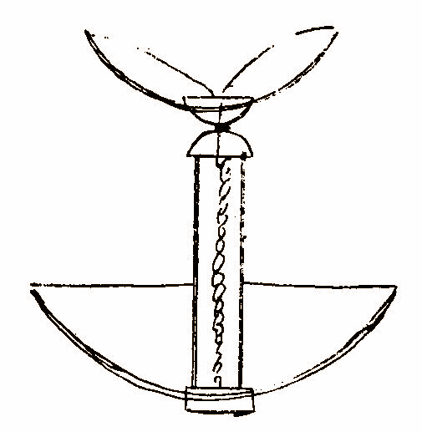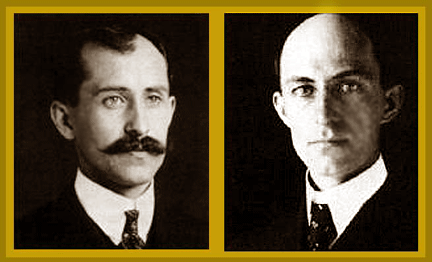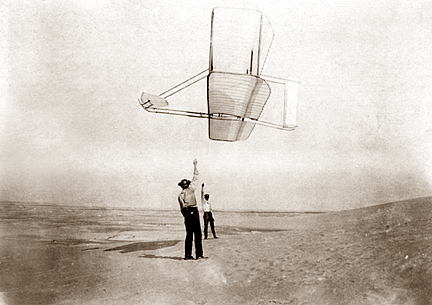|
 The
Wright brothers received their introduction to aeronautics in 1878, when
their father, a bishop in the United Brethren Church, bought them a
rubber-band-powered helicopter toy during one of his many trips. Both loved
to tinker with mechanical things, though neither one attended college–
Orville didn’t even finish high school. The
Wright brothers received their introduction to aeronautics in 1878, when
their father, a bishop in the United Brethren Church, bought them a
rubber-band-powered helicopter toy during one of his many trips. Both loved
to tinker with mechanical things, though neither one attended college–
Orville didn’t even finish high school.
The two brothers ran a bicycle shop on West Third Street
in Dayton, Ohio, earning a moderately good living. Wilbur’s interest in
flight began upon hearing of the death of glider pilot Otto Lilienthal. On
May 30, 1899, he wrote to the Smithsonian Institution requesting information
about published material on aeronautics. Convinced that human flight was
possible, the brothers plunged into an intensive and methodical course of
study.
And
for all their reading, they were struck by how little was really known about
the subject. Groping their way through a maze of unsubstantiated and
frequently contradictory material, the brothers found that no one had
successfully tackled the very basic question of effective flight control.
 Powered flight required three things: wings that generated
sufficient lift, a light yet powerful motor, and a control system. Wilbur
Wright put the emphasis on a control system. Powered flight required three things: wings that generated
sufficient lift, a light yet powerful motor, and a control system. Wilbur
Wright put the emphasis on a control system.
Designing one for their craft presented a puzzling
problem. Here was a machine that had to be controlled in three axes of
motion–the yaw axis, in which the nose of the airplane turns left or
right; the pitch axis, in which the nose moves up or down; and the roll
axis, in which one wing banks higher than the other. Every experimenter
understood the necessity of turning left and right and moving up and down,
but roll was something new and, for many, something to be avoided.
Wilbur had seen how birds banked in turning. As a bicycle
builder and rider, he had also noted how cyclists naturally leaned into a
turn. Now, in applying his observations to the flight problem, he was the
first to understand the advantage in maneuverability that could be had by
initiating a roll.
 One day in July 1899, while working in the bicycle shop,
he began idly manipulating an empty inner-tube box in his hands. He suddenly
saw how, with a simple twist, the opposite ends of the box could be
presented at different angles to the wind, providing a way to control an
airplane roll. Though still three years from understanding the importance of
rudder controls in turning, Wilbur’s breakthrough was the basis for
tightly banked airplane turns. One day in July 1899, while working in the bicycle shop,
he began idly manipulating an empty inner-tube box in his hands. He suddenly
saw how, with a simple twist, the opposite ends of the box could be
presented at different angles to the wind, providing a way to control an
airplane roll. Though still three years from understanding the importance of
rudder controls in turning, Wilbur’s breakthrough was the basis for
tightly banked airplane turns.
That same month, the Wrights set to work building a
biplane glider/kite with a five-foot wingspan. They attached cords to the
wing tips so that the kite flyer could control the wing-warping mechanism.
Standing on the ground with the cords to his glider/kite, they could soon
make the craft swoop and dive like an eagle. It was a thrilling moment.
Wilbur had solved one of the major problems of flight, for their glider was
the world's first flying device capable of being controlled both laterally
and longitudinally. They immediately began construction of a larger glider–one
large enough to carry a man.
On November 27, 1899, Wilbur contacted the U.S. Weather
Bureau requesting information on wind conditions in various parts of the
country. The Wrights needed strong and steady winds for their experiments.
The bureau's suggested Kitty Hawk, a tiny village on the Outer Banks of
North Carolina.
Next: An Adventure of a Lifetime
|
